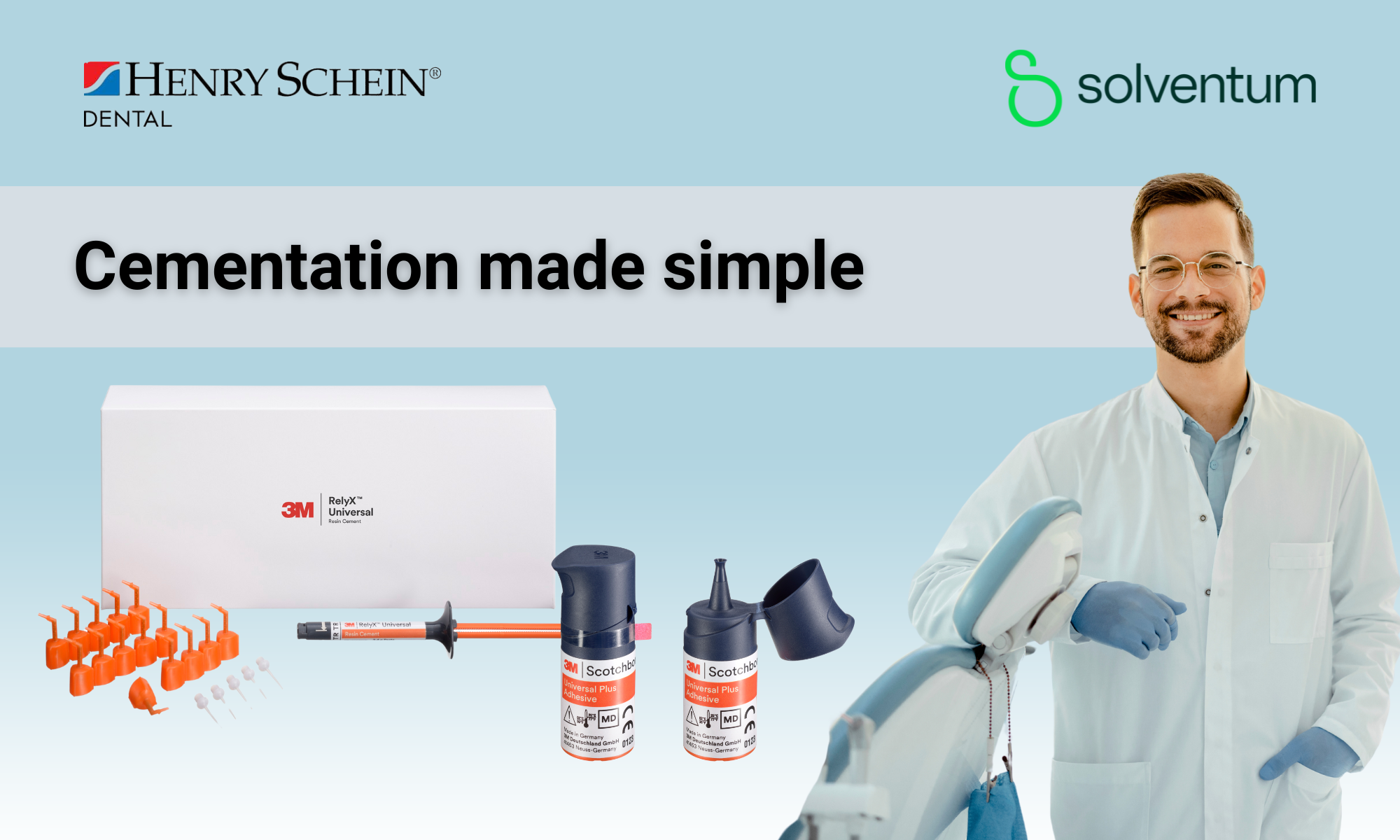Simplifying cementation in your dental practice

Dental cement is a staple of any dental practice. You need products that streamline your workflows from manufacturers you can trust. With so many different use-cases and indications, the busy marketplace can be confusing. Let us help you cut through the noise to simplify cementation in your dental practice.
You want the same thing from all your dental materials: effectiveness, safety, ease-of-use, accuracy, and predictability. In essence, this all boils down to one thing: simplicity. Simplicity for you, your inventory, and your procedures.
But true simplification can seem unrealistic, especially when dealing with complex procedures, and cementation is still one of the more complex – and often confusing – elements of indirect restorations.
What makes cementation confusing?
Indirect restorations are usually multistep procedures that can be time-consuming and complicated. On top of this, crown cementation is one of the most critical steps in the restorative workflow; mistakes made at this stage can cause restorations to fail earlier than they should and end up being costly to both patient and practitioner. You could even lose patients if they are dissatisfied with the work.
What do you need for easy cementation?
 Isolation and cement selection are the two key factors that will dictate the success of your cementation process. Mastering isolation is simpler, relying on dental skill and with few methods to choose from. On the other hand, selecting the best cement for you involves many factors, including restorative material, substrate, indication, and more.
Isolation and cement selection are the two key factors that will dictate the success of your cementation process. Mastering isolation is simpler, relying on dental skill and with few methods to choose from. On the other hand, selecting the best cement for you involves many factors, including restorative material, substrate, indication, and more.
Even just navigating these variables is difficult. The saturated dental cement marketplace only makes it harder. With so many dental cements to choose from, finding the right choice is overwhelming.
How has cementation changed?
 As medical technology continues to advance and the needs of restorations have changed, cementation and bonding materials have to continually evolve to meet modern needs. As a result of this, there is now an overabundance of cement types available – many with only very small differences between them. Others require additional conditioning and bonding agents, while some are only suitable for one specific indication or situation.
As medical technology continues to advance and the needs of restorations have changed, cementation and bonding materials have to continually evolve to meet modern needs. As a result of this, there is now an overabundance of cement types available – many with only very small differences between them. Others require additional conditioning and bonding agents, while some are only suitable for one specific indication or situation.
There is a good side to this variety of choice, as it is likely that there is the perfect cement for any and every indication out there. However, the problem is that this has also led to a confusion of choice, and dentists ending up with a huge inventory of cements with overlapping indications and dawning expiration dates.
The solution: simplify and standardise your cements
It's a common problem: during an inventory check you find a pile of cements for the same indication, all only partly used. Or perhaps you’ve found expired cements you’ve had to throw away, the material and money spent to buy them wasted.
It’s not a situation any dental practitioner wants, but one most have found themselves in.
The first step to simplifying your cementation process is simplifying your inventory. Having a look at the cements you have in your practice, and reviewing which ones you use and which ones you don’t, can help to achieve a streamlined workflow. At the very least, it will tidy up your inventory management!
Why refine your inventory?
 By reducing your inventory to just a few carefully selected cements, you can reduce instances of overlapping products and the risk of expiration, without sacrificing your ability to cover all indications. Moreover, by reducing the number of products you work with, you can enhance your expertise with the products you have chosen.
By reducing your inventory to just a few carefully selected cements, you can reduce instances of overlapping products and the risk of expiration, without sacrificing your ability to cover all indications. Moreover, by reducing the number of products you work with, you can enhance your expertise with the products you have chosen.
Benefits of refining your cement inventory:
- Simplifies which cement to choose.
- Reduces wasted product.
- Creates expertise.
Improve results by narrowing your materials
With a constantly revolving carousel of products, you and your team will not be getting particularly familiar with any product, stopping you from making the most of any product. But if you consistently use the same materials, you’ll get to know the unique chemistry, the handling, and the pros and cons of everything you use – improving results and minimising the risk of errors.
Universal Resin Cement: can it help your practice?
The next step in simplifying your cementation process is in finding a universal solution. A great example of this is 3M™ RelyX™ Universal Resin Cement, which is suitable for both self-adhesive and adhesive procedures. Combined with 3M™ Scotchbond™ Universal Plus Adhesive, you can eliminate the need to juggle multiple cements, successfully reducing complexity in your procedures, and your inventory.
-1.png?width=358&height=358&name=Untitled%20design%20(38)-1.png) The RelyX Universal Resin Cement
The RelyX Universal Resin Cement
- Improved flow with initiator system makes clean-up easy and helps reduce waste.
- Suitable for the vast majority of adhesive and self-adhesive resin cement indications.
- Strong dentine bond with any curing method.
- Straightforward to use.
Clinical case study using RelyX Universal Resin Cement

Remove excess easily after tack curing.

This ensures clean margins after polishing.

The self-sealing automix syringe allows for hygienic storage. The cement can be used with or without the dedicated 3M™ Scotchbond™ Universal Plus Adhesive.

The 3M™ RelyX™ Universal Micro Mixing Tip also minimises material waste.

